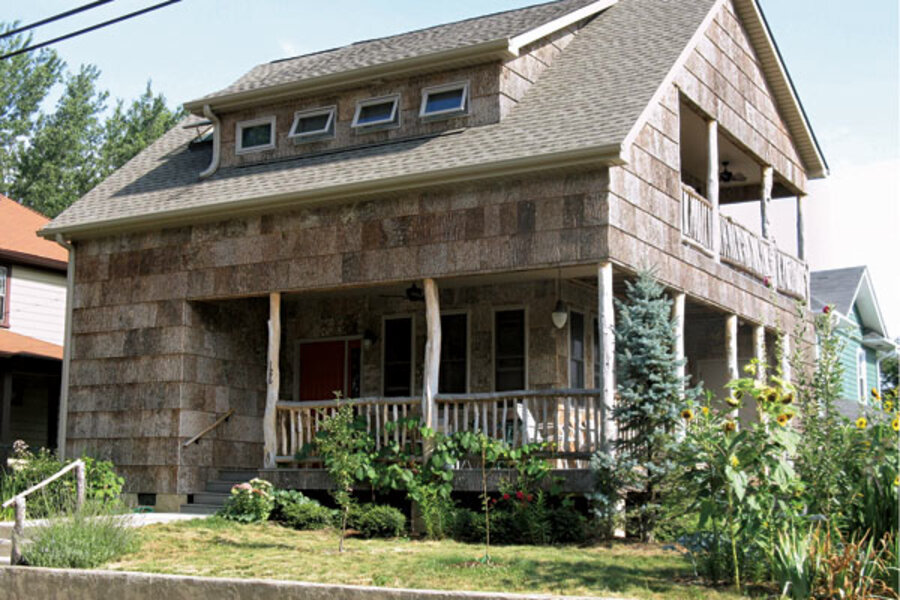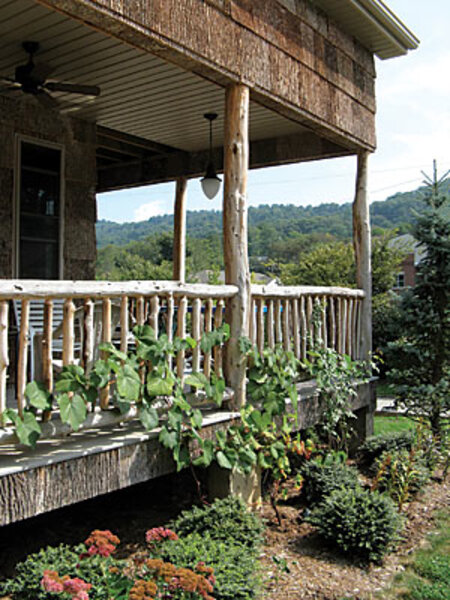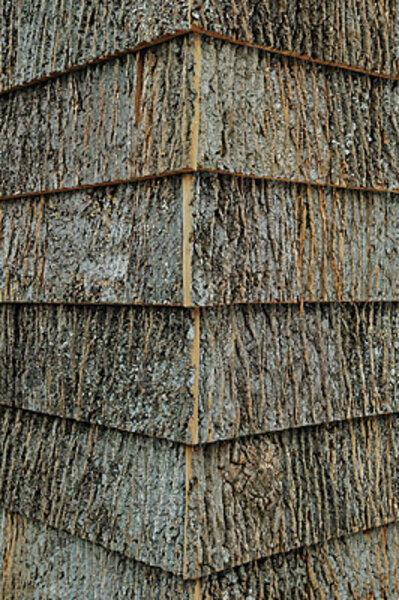Bark houses are built with nature’s shingles
Loading...
| Asheville, N.C.
The rustic bungalow near downtown Asheville is a traffic stopper. Covered in big overlapping shingles of tree bark – rather than the usual wood, brick, or stone – it looks odd, a bit like a square tree.
Although the unusual house appears antique and rooted in the past, it was completed just last year.
Bark may look old-fashioned, but as a recently rediscovered and reengineered building material, it fits the profile of a modern, environmentally sustainable choice for new construction – residential or commercial, interior or exterior.
The poplar bark from which the shingles are made is salvaged from timber operations, and otherwise would be burned, mulched, or left to rot. Among the benefits of top manufactured bark shingles: They contain no chemicals, having been processed solely with sanitizing kiln heat. Bark’s insulating heft keeps heating and cooling bills low. Bark requires no paint, stain, or other treatments. And shingles can last 75 years or more without maintenance.
I’ve learned all this because that Asheville house is mine. What began simply as a way for my husband, Saul, and me to have a house that would never need painting – we worked as house painters in college – has grown over the past two years into a living laboratory experiment.
Saul and I didn’t know what to expect from a bark house, or whether there would be anything to notice at all. But it does feel different: entirely wind resistant in a storm, slow to warm up in summer, and quick to warm up in winter.
“In the context of high design, it has tremendous appeal,” says New York architect Andre Kikoski, one of the few professionals putting bark into sleek modern designs, including the internationally recognized Second Home Kitchen and Bar, in Denver.
“The appeal is universal,” Mr. Kikoski says. He likes the interesting patterns of light and shadow that are created in the bark’s furrows when light shines on it from various angles. “And it has amazing acoustic properties. But best of all is that people can’t resist walking up to the material and touching it.”
Although bark-covered structures date back millenniums in some societies, the first appearance of a neatly squared bark building shingle – from American chestnut trees – dates back to 1895 in the southern Appalachian Mountains. Architect Henry Bacon, who also designed the Lincoln Memorial, invented the style at the resort community of Linville, N.C., where he used hand-trimmed slabs of two-inch-thick chestnut bark to cover homes. Some of those summer homes are still in use today, the exteriors untreated in any way.
When chestnut blight wiped out the main source of bark in the early 20th century, bark houses were no longer built. But in the past two decades, bark shingles have made a comeback, now almost exclusively in poplar.
“It’s fantastic, it’s local, it’s durable, it’s cool,” says Matt Siegel, green building director at the Western North Carolina Green Building Council in Asheville. But he cites the price of the shingles as a possible deterrent to increased use and says that installation takes more time.
Bark shingles can cost twice as much as conventional cedar siding, but the upfront costs even out over time, experts say.
“Twice the cost upfront sounds like a lot,” says Brent Simmons of Banner Elk, N.C., manager of green programs and sustainable product sales at Mountain Lumber Company. And that can cause homeowners concern. “But if you spread it over many years, the increase is less than 1 percent for the whole cost of the house. It’s a minimal up-charge for something maintenance-free.”
He adds: “The biggest variable is the maintenance schedule. Every five to 10 years, the homeowner may need to paint or stain [cedar shingles].” But not bark ones.
Michael Chandler of Chandler Design-Build, who is constructing a new 3,200-square-foot house near Chapel Hill, N.C., says that using poplar bark shingles rather than cedar siding will add about $12,000 to the cost. But there’s an immediate advantage: “Bark is made to look old when it’s new. That gives it a sense of having been there forever.”
My husband and I have found the cost of heating our 1,400-square-foot, two-story house surprisingly low, and that means savings year after year. Our bill for natural-gas heating, on-demand hot water, clothes dryer, and stove has never exceeded $100 a month, even in winter. (We pay .96361 cents per therm.) More surprising to me is how little we bother to use the air conditioning in summer. Although the house has a southeastern exposure, the thick bark – in conjunction with covered porches and indoor ceiling fans – can keep the temperature well below 80 degrees F. most of the time.
And bark’s sound-insulating qualities are prodigious. With the windows closed, I may as well be in the country for all the traffic noise that intrudes from our busy street corner.
When buying bark shingles, consumers need to do their homework to make sure they’re getting a product that lives up to its potential. Practice has shown that bark’s longevity mostly depends on three things: how well it’s dried by the manufacturer to kill any microorganisms and stabilize the product structurally; how well it’s stored to keep it flat before installation, and how well it’s installed.
To assure that bark shingles have been produced sustainably, consumers should make certain that suppliers guarantee that they use bark only from managed forestlands, with certification from such organizations as the Forest Stewardship Council, the Sustainable Forestry Initiative, or the American Tree Farm System.
Buyers should also use builders who have been trained in bark installation, because the shingles require special handling and nailing techniques, and some unusual design considerations.
“It’s not rocket science to put it on,” explains builder Daniel Hemp, “but you have to learn how to do it right.”
My own interest in building a bark house came while I was helping to write a book on the subject (“Bark House Style: Sustainable Designs From Nature,” with Chris McCurry).
By the time Saul and I had the opportunity to build a new house on a vacant lot in a downtown neighborhood, the historical research for the book had convinced me that there was no other material so tough or so interesting, for the price.
We opted to go all the way rustic with peeled locust porch supports and railings that, like bark, will never need painting.
I have gotten used to my “funny-looking” bark house, even if passing motorists slow down and stare. Each shingle is unique, with lovely gray and brown patterns and bits of moss and lichen. Occasionally a squirrel pops its head over the porch railing, maybe looking for nuts on this curious “tree.”
Blogging rumors to the contrary, these houses do not attract woodpeckers searching for bugs beneath the bark. Kiln-drying kills any insects and also the sugary layer insects may inhabit in living trees.
Mr. Simmons, whose own part-bark house mixes modern and traditional elements, finds that the bark is attractive to at least one bird species: Nuthatches perch on his house with seeds they want to crack on the hard, treelike surface, and he enjoys the up-close bird-watching.
“One time there were 10,” Simmons says. “I couldn’t get to my camera fast enough.”
Editor’s note: The Monitor's Environment section has a new URL. And there's a new URL for its Bright Green blog. We hope you'll bookmark these and visit often.







